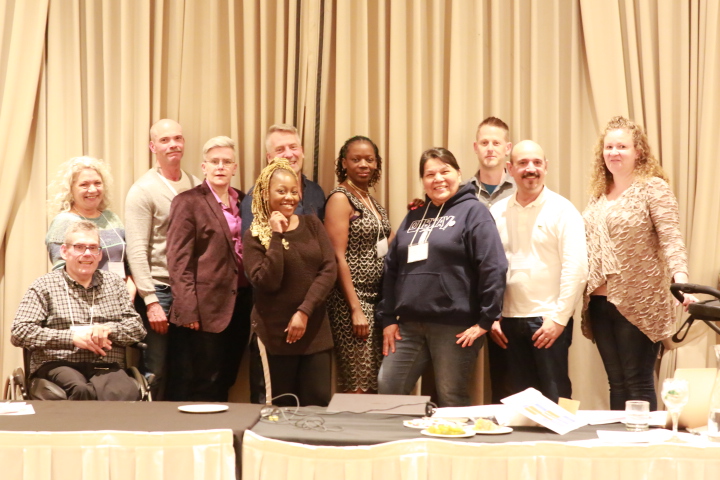Here are the seven ways that the CTN works towards the meaningful involvement of people living with HIV in current research via the Community Advisory Committee.
The CTN’s Community Advisory Committee (CAC) was one of the first models for community-based and participatory HIV research. As an embodiment of the maxim “Nothing about us without us,” the CAC works to ensure that members of the HIV community are involved in all steps of clinical research, from trial design all the way through knowledge translation and dissemination.
Founded in 1993, the CAC originally set the CTN apart from other HIV research organizations for its novel approach to the meaningful involvement of people living with HIV in research. Now, hundreds of community members have weighed in on the CTN’s clinical trials over the past three decades through the CAC, reviewing over 300 research proposals to date. With their help, Canadian scientists have made ground breaking discoveries in treatment, prevention, and care for people living with HIV.
But how exactly do they do it?
Here we break down the seven ways that the CTN works towards the meaningful involvement of people living with HIV in all aspects of research via the CAC.
1. Propose research that is relevant for the community
 To this day, many of the CTN’s trials began as conversations over coffee or tea at our national meetings. Before trial design even begins, CAC members bring forward research ideas that are important and relevant for their community. From neurocognitive imaging for children born to mothers living with HIV (CTN 315), to transgender-affirming education for HIV clinicians (CTN 317), the CAC brings forth research ideas that address the priorities of the community to ensure that no one segment of the population bears the brunt of this epidemic. It is critical for CTN scientists and researchers to know what issues are affecting people living with HIV, and how to present their findings in a way that is meaningful and useable for the community. Many CAC members themselves bridge the divide between community member and researcher, and as a result, CAC members have served numerous times as official investigators on CTN clinical trials.
To this day, many of the CTN’s trials began as conversations over coffee or tea at our national meetings. Before trial design even begins, CAC members bring forward research ideas that are important and relevant for their community. From neurocognitive imaging for children born to mothers living with HIV (CTN 315), to transgender-affirming education for HIV clinicians (CTN 317), the CAC brings forth research ideas that address the priorities of the community to ensure that no one segment of the population bears the brunt of this epidemic. It is critical for CTN scientists and researchers to know what issues are affecting people living with HIV, and how to present their findings in a way that is meaningful and useable for the community. Many CAC members themselves bridge the divide between community member and researcher, and as a result, CAC members have served numerous times as official investigators on CTN clinical trials.
2. Review research protocols
 When reviewing a clinical trial, each member of the CAC answers one question: would you participate in this study? This central question helps CAC members put themselves in the shoes of study participants and predict any adverse impacts that may not have been considered by scientists while designing a trial.
When reviewing a clinical trial, each member of the CAC answers one question: would you participate in this study? This central question helps CAC members put themselves in the shoes of study participants and predict any adverse impacts that may not have been considered by scientists while designing a trial.
Each member of the CAC reads every clinical trial protocol, considering all the while how the trial may affect participants and the wider community. They keep an eye out for safety, equity, justice, and relevance. The group then scores the trial protocol on a scale of 1-5. The protocol is generally rejected if it doesn’t reach a score of 3.5, and is sent back to be amended and re-reviewed before it can proceed. Above 3.5, the trial can go ahead, sometimes with amendments as requested by the committee.
3. Review informed consent forms
An informed consent form is an info sheet that potential participants read before participating in a study. Informed consents outline the importance of the research, define the criteria for participation, describe what participants should expect — including any potential risks or benefits — clarify how the results will be shared, and provide further details on issues such as renumeration, biobanking, or follow-up appointments.
 Informed consent forms are critical in clinical trial design, since they influence whether someone chooses to participate or not. These documents also provide accountability and ensure that participants are treated fairly and equitably. The CAC assesses which information should be included, or whether the risks and benefits associated with participation are clearly laid out. Finally, they make sure that the language on the consent form is readable and accessible to all members of the community.
Informed consent forms are critical in clinical trial design, since they influence whether someone chooses to participate or not. These documents also provide accountability and ensure that participants are treated fairly and equitably. The CAC assesses which information should be included, or whether the risks and benefits associated with participation are clearly laid out. Finally, they make sure that the language on the consent form is readable and accessible to all members of the community.
4. Ensure diversity in trial recruitment
 While some trials investigate issues only relevant to a certain subset of the population, such as children, men who have sex with men, or people living with both HIV and HCV, for the majority of trials diversity is an asset; a diverse cohort of participants leads to results that are truly generalizable for the general population.
While some trials investigate issues only relevant to a certain subset of the population, such as children, men who have sex with men, or people living with both HIV and HCV, for the majority of trials diversity is an asset; a diverse cohort of participants leads to results that are truly generalizable for the general population.
Once a clinical trial gets underway, CAC members play a crucial role in promoting and recruiting participants from their community. They connect researchers to gathering places, support groups, or online forums where community members connect, and help researchers to communicate the personal and community-wide benefits that can come from participation.
5. Represent the community on other CTN committees
 The CTN houses a number of other committees that ensure the success of the network’s research trials. These include the Scientific Review Committee, the Data Safety and Monitoring Committee, and the Funding Committee. To guarantee the meaningful engagement of people living with HIV in all functions of the network, at least one member of the CAC serves on each of these committees. Just like with the CAC, community representatives on all committees work to ensure that the CTN’s activities meet the needs and research priorities of people living with HIV.
The CTN houses a number of other committees that ensure the success of the network’s research trials. These include the Scientific Review Committee, the Data Safety and Monitoring Committee, and the Funding Committee. To guarantee the meaningful engagement of people living with HIV in all functions of the network, at least one member of the CAC serves on each of these committees. Just like with the CAC, community representatives on all committees work to ensure that the CTN’s activities meet the needs and research priorities of people living with HIV.
6. Knowledge translation and dissemination
 Once a clinical trial is underway and data starts rolling in, the process of knowledge translation begins. Knowledge translation is an ongoing process that requires collaboration between researchers and community members, but ultimately serves to put research in the hands of those who need it most: those living with HIV and their care takers. Successful knowledge translation can change public policy, rewrite best practices, transform clinical care, and empower communities.
Once a clinical trial is underway and data starts rolling in, the process of knowledge translation begins. Knowledge translation is an ongoing process that requires collaboration between researchers and community members, but ultimately serves to put research in the hands of those who need it most: those living with HIV and their care takers. Successful knowledge translation can change public policy, rewrite best practices, transform clinical care, and empower communities.
Members of the CAC help researchers translate their findings in a way that is meaningful and accessible to their community, through channels such as social media, news outlets, or in–person at gatherings within their community.
7. Mentorship
 Members of the CAC are themselves educators, advocates, and researchers. While CAC members enjoy unprecedented access to the ins and outs of the most up-to-date HIV research, CAC members are also themselves mentors for new researchers, postdoctoral fellows, and younger members of the HIV community.
Members of the CAC are themselves educators, advocates, and researchers. While CAC members enjoy unprecedented access to the ins and outs of the most up-to-date HIV research, CAC members are also themselves mentors for new researchers, postdoctoral fellows, and younger members of the HIV community.
The CAC accepts up to two apprentices on year-long contracts. While the apprentices cannot vote to accept or reject a clinical trial, they still participate in every other activity of the committee. They learn about the inner workings of the CTN as a whole, and are often invited to apply for full committee membership once their one-year term is up.
The CAC is currently seeking nominations for new committee members. Interested candidates can find additional information and application procedures here.







